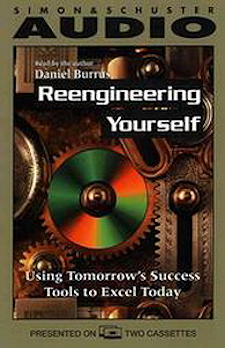 This was a pretty quick audiobook:
This was a pretty quick audiobook:
Reengineering Yourself: Using Tomorrow’s Success Tools To Excel Today
by Daniel Burrus
Nightingale-Conant (August 1, 1996)
ISBN-10: 0671572938
ISBN-13: 978-0671572938
I would rate this book a 7.9 / 14.0 on the Richardstep.com Book Scale.
It was relatively decent in quality, adequately informative, and pretty enjoyable ‘read’. Most of the book revolved around ideals and dreams that the reader *should* turn around and apply to his or her own “future-view”… though the methods to actually carry out this path are not quite concretely described. The section on creativity really piqued my interest and had some good ideas. I would recommend this book.
Below are my personal notes from the book:
Are you positioning yourself to thrive in the past, current, or future?
– Does your job prepare you / stimulate you as a 90’s philosophy guru, or a future innovator?
The future isn’t what it used to be! -Yogi Berra
A shift in management is needed – from crisis management to opportunity management.
Commit to 1 hour per week to do this:
– ask what are problems that are fully predictable / near future?
– ask what can I do to solve these problems?
Types of React to change:
– Indifference: most popular coping method; formula for disaster; people underestimate their capabilities
– Passive Resistance: so frightened of change, we wish it would go away; we can only react
– Acceptance: embracing the change and becoming actively involved in guiding it; learning how to cope and positively influence
A tool and some vision can help us do things that were once impossible. (i.e.-fly in plane, drive car, sit on stool)
Obsolescence is a non-issue – pay attention to how you use it instead. Creative application: creative ways to use existing things.
Flash Points: price and application low enough that most believe they must have the item. Where are we in terms of flash points? Look for them, the current progress toward them, and how to embrace / innovate relative to the flash point.
New Tools to Shape Your Destiny Today:
– digital interactive television: what information could you provide through this medium (this is web 2.0)
– advanced flat panel displays: how to use? where to place? Where could this replace paper displays?
– telecomputer, personal communication networks, digital cellular telephones, electronic notepads: all handled by smartphones now
– more tech that is now old… (parallel processing, rumba, virtual reality)
– advanced expert systems: software programs that capture expertise of the best of the best people and apply those findings to a training program for the rest of the people / world
– neural networks: learning programs (tivo, google adsense, etc)
– Genetic modification: hello Monsanto
21st Century Job Skills:
– Child-like wonder & curiosity
– Open minded
– Creativity (atrophies with lack of use)
– Willingness to learn new things
– Being comfortable with new technology
– Problem Solving skills (21st century centric)
– Communication Skills
21st Century Mindset – Need a new perspective on:
– Ourselves, Our world, possibilities, Sphere of influence, How we lead, How we manage, How we market/sell, How we communicate
Look at what the other people are doing and DON’T DO IT. Don’t compete – BE the next thing.
When you are not #1, you strive to be #1. When you are #1, then you try to… distance yourself from the rest!
Are you a ‘competer’ or an innovator?
Creativity isn’t power until it is focused. All of these wonderful creative ideas, unrealized and unfocused, will go nowhere fast.
Creativity Profile:
-optimistic about future, open about alternatives, highly curious / observant, independent thinkers, can break bad habits, adventurous, willing to take risks, open to new experiences, take action and make things happen, full of commitment, and non-conformists
Types of Creativity:
– Discovery (low): observant
– Invention (mid): intuitive insight / mental database of knowledge. Focused in area of internal passion. Observation/experimentation.
– Creation (high): making new from ‘nothing’
“Creativity Locks” That People Say:
– “I’m not a creative person”
– “Be as practical as you can”
– “Follow all the rules”
– “That’s not logical”
– “Avoid ambiguity at all costs”
– “Don’t be foolish”
– “Having fun is frivolous”
– “That’s not my area – I wasn’t trained in that”
– “To make a mistake is wrong”
– “That’s not the right answer”
– “I can’t do that”
– “Someone else must already be doing this”
Techniques to Solve Problems / Be Creative:
– Put two or more things together in a new way (e.g.-trains & restaurants)
– Opposites work better (take a concept and flip it around backwards: e.g.-take a sailboat sail and put it on the bottom… now a hydrofoil); become a multi-sensory observer (see environment from perspective of another – use all senses)
– Concept Challenge – take the concept and challenge it no matter how fundamental it is (chair has a back rest and butt rest: what if we change that up? Dominant idea of a train is ‘transportation’… take out transportation and substitute ‘entertainment’… now you have a new trip with no focus on destination)
– Possibility Thinking – asking what-ifs
Idea: use technology NOT as originally intended.
– look at something you think you don’t need and try to figure out a way you COULD use it.
– look back to the failures of the past and apply it now (new tech/methods may make it work) – figure out way to do it now
– use old technology in new ways
Look to 10 years in the future and plan back to today.